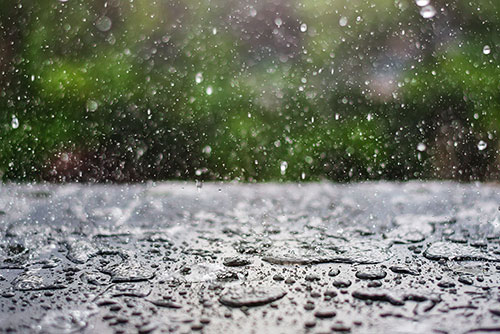Monsoon Mayhem
Monsoon brings relief from the burning summer every year but it also brings along multiple infections transmitted by tiny pathogens. The most common diseases are transmitted through mosquitoes, air and contaminated food and water. Let us quickly enlighten ourselves on these tiny pathogens, their effects on us and also some preventive measures to prevent these infections.

Infections Caused by Mosquito Bites
Rains during the monsoon season provide opportunities for the breeding of mosquitoes in water-logged areas leading to dengue and malarial fevers.
Dengue fever is caused by a family of viruses that are transmitted by mosquitoes. It is spread by the tiger mosquito (Aedes aegypti). Symptoms include severe joint and muscle pain, headache, fever, exhaustion and rash. Complication of dengue fever is called dengue haemorrhagic fever (DHF) which can lead to bleeding and circulatory collapse (shock).
There are no specific antibiotics or antiviral medication to treat it. Hence, it is very important to be cautious about any high-grade fever lasting more than 24 hours during the monsoon and equally important to diagnose dengue using advanced real-time PCR, dengue NS1 antigen and dengue IgM or IgG at the earliest.
Malaria is caused by a protozoa which is transmitted by Anopheles species of mosquitoes. This species breeds in dirty water; hence, water logging during the rainy season provides conducive conditions for breeding of the mosquitoes. Malaria is characterized by fever, body ache, chills and sweating. If untreated, it can lead to complications like jaundice, severe anaemia or even liver and kidney failure. Deaths are caused by P. falciparum – the most dangerous type of malaria also known as cerebral malaria.
Accurate diagnosis of malaria can be easily done by microscopic examination of blood films. However, the sample must be collected during the fever spike and examined by the pathologist. Newer antigen-based rapid diagnostic tests and fluorescent-based detection methods are also available.
As malaria can be treated with antimalarial medications successfully, it is very important to diagnose malaria and differentiate it from dengue which also presents with similar symptoms.
Air-Borne and Droplet Infections Like Influenza (Cold and Flu) and COVID-19
COVID-19 is still causing waves in various parts of the world. Hence, we can’t let our guard down yet. Influenza (flu) and COVID-19 are both contagious respiratory illnesses, but they are caused by different viruses. COVID-19 is caused by infection with a coronavirus first identified in 2019, and flu is caused by infection with influenza viruses which are endemic in our country and flare up during the monsoon. Compared to flu, COVID-19 can cause more serious illnesses and people can be contagious for a longer time. Hence, COVID-19 must be first ruled out using RT-PCR, which are approved and affordable assays. Physicians then can differentiate COVID-19 from other respiratory infections accurately and prescribe the required medication.
Infections Caused by Contaminated Food and Water
Hot bajjis and samosas are a must during the rainy days. However, if they are not prepared hygienically, it can lead to diseases like the following:
Typhoid is a waterborne bacterial infection caused by bacteria called Salmonella. This disease is caused by the consumption of food or water contaminated with the faeces of an infected person. Common symptoms are fever, headache, sore throat & abdominal pain. The bacteria can remain in the gallbladder of the patient even after he/she is cured leading to relapses. Diagnosis of typhoid can be accurately done by blood culture, rapid typhoid and widal.
Hepatitis A virus causes a highly contagious liver infection. It is a waterborne viral infection caused by the consumption of contaminated water or food and also through flies. Symptoms include jaundice (yellow eyes and skin, dark urine), stomach pain, loss of appetite, nausea and fever. Blood tests are used to detect the presence of antibodies to hepatitis A. Leptospirosis, also known as Weil’s Syndrome, is caused by a spirochete which is transmitted through contact with dirty water contaminated with rodent urine or excreta during the monsoons. It is accompanied by shivers, muscle pain, headache and fever.
Gastro-intestinal infections like vomiting, diarrhoea and gastroenteritis are caused by many other bacteria and viruses after consumption of stale, uncovered, or contaminated food and water.
Prevention is always better than cure and monsoon sicknesses can be prevented by taking timely measures like the following:
- Don’t allow water to stagnate or collect anywhere in and around the house.
- Use mosquito nets and mosquito repellents/creams.
- Wear a mask wherever required and cover your mouth and nose while coughing or sneezing.
- Follow hand hygiene at all times and use hand sanitizers while travelling.
- Keep your children away from people who are already infected and ensure they wash their hands and feet thoroughly once home from outdoors.
- Always consume clean drinking water.
- Wash fruits and vegetables thoroughly before consumption.
- Eat in hygienic eateries as infected food handlers can transmit typhoid and hepatitis A.
- It would be wise to skip the pani puri and samosas from unhygienic roadside eateries during the rainy season.
- KINDLY VACCINATE AGAINST COVID-19 AND FLU.

Dr. Uma Senthil Kumar
Consultant – Microbiologist
Kauvery Hospital, Chennai

